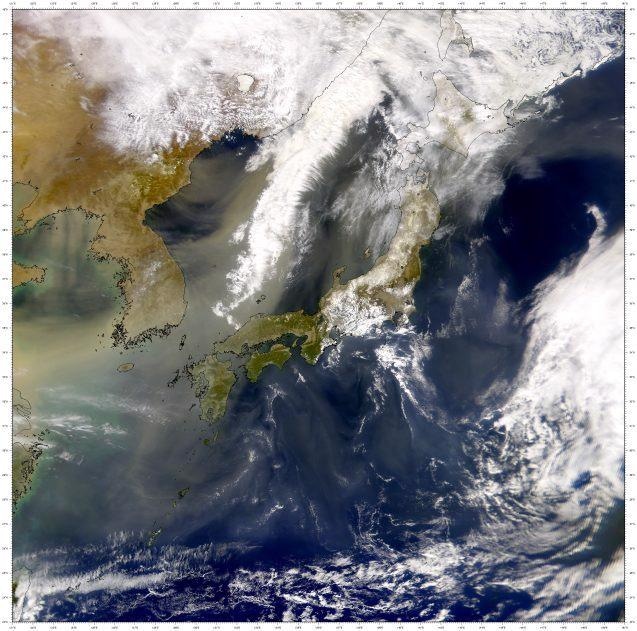Jan 7 2021
The westerlies, also known as westerly winds, have a crucial role to play in climate and weather, both on a local and global scale, by steering tropical cyclones, affecting ocean circulation and influencing precipitation patterns. Therefore, it is crucial to find a method to assess how they will change with the warming climate.
 Image of a dust plume leaving China and crossing the Korean Peninsula and Japan. Researchers studied the dust deposited in ancient ocean sediments in order to understand how wind patterns in this area have shifted in the past. Their findings provide a better understanding of how the winds may change in the future. Image Credit: SeaWiFS Project, NASA/Goddard Space Flight Center, and ORBIMAGE.
Image of a dust plume leaving China and crossing the Korean Peninsula and Japan. Researchers studied the dust deposited in ancient ocean sediments in order to understand how wind patterns in this area have shifted in the past. Their findings provide a better understanding of how the winds may change in the future. Image Credit: SeaWiFS Project, NASA/Goddard Space Flight Center, and ORBIMAGE.
Normally, the westerly winds blow from west to east across the middle latitudes of the planet. However, researchers have observed that in the past several years, these winds are varying and migrating poleward.
The study indicates that this can be attributed to climate change. However, investigators have been arguing whether the poleward movement of the westerly winds will persist as atmospheric carbon dioxide (CO2) and temperatures increase under upcoming warming scenarios. Scientists have found it hard to solve this scientific question because knowledge about the westerly winds in past warm climates has been rather limited, until now.
In a study recently published in the Nature journal on January 6th, 2021, climate scientists from the Lamont-Doherty Earth Observatory at Columbia University explained a new technique of monitoring the ancient history of the westerlies—a proxy for what one may experience in an upcoming warming world.
Jordan Abell, the lead author of the study and graduate student of Lamont-Doherty Earth Observatory, and his advisor Gisela Winckler have designed a method to apply paleoclimatology—the study of past climate—to the question related to the behavior of the westerlies, and discovered proof that indicates that atmospheric circulation patterns will change as the climate warms.
This latest finding represents a breakthrough in one’s interpretation of how the winds changed in the earlier days and how they may continue to change in the days to come.
The team used the dust found in ancient, deep-sea sediments as an indirect tracer of wind and successfully rebuilt wind patterns that took place three to five million years ago. The authors knew that winds—in this case, the westerly winds—transfer dust from desert areas to remote locations, and went on to analyze the cores from the North Pacific Ocean.
This region is located downwind from Eastern Asia, which is one of the biggest dust sources at present and a familiar dust-generating area for the last several million years. By quantifying the dust in cores from two varied sites located thousands of kilometers away, the team was able to plot the variations in dust and consequently the westerly winds.
"We could immediately see the patterns. The data are so clear. Our work is consistent with modern observations, and suggests that wind patterns will change with climate warming."
Jordan Abell, Study Lead Author and Graduate Student, Lamont-Doherty Earth Observatory, The Earth Institute, Columbia University
The researchers observed that during the warm parts of the Pliocene (about three to five million years ago, when the Earth was roughly 2–4 °C warmer than present times but more or less had the same concentration of CO2 in the atmosphere as today), the westerly winds, around the world, were situated closer toward the poles than during the colder intervals afterwards.
"By using the Pliocene as an analogue for modern global warming, it seems likely that the movement of the westerlies towards the poles observed in the modern era will continue with further human-induced warming."
Gisela Winckler, The Earth Institute, Columbia University
The movement of such winds holds major implications for precipitation patterns and storm systems. And while this study does not exactly indicate where it will rain more or less, it does show that the wind and precipitation patterns will vary as the climate warms.
"In the Earth history record, tracking down movements of wind and how they’ve changed, that’s been elusive because we didn’t have a tracer for it. Now we do."
Gisela Winckler, The Earth Institute, Columbia University
Journal Reference:
Abell, J. T., et al. (2021) Poleward and weakened westerlies during Pliocene warmth. Nature. doi.org/10.1038/s41586-020-03062-1.